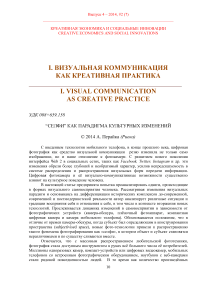“Selfie” as the paradigm of cultural change
Автор: Peraica A.
Журнал: Креативная экономика и социальные инновации @cesi-journal
Рубрика: Визуальная коммуникация как креативная практика
Статья в выпуске: 2 (7) т.4, 2014 года.
Бесплатный доступ
Since the introduction of the mobile phone technology, at the end of the last century, digital photography as a medium has changed rapidly, especially regarding the image distribution. With a new stage of Web2 interface development in social networks, such as Facebook, Twitter, Instagram et al these changes become more profound, especially regarding unpredictability of the distribution. Basing a differentiation on historic layers of pre-modern, modern and postmodern relationship to self, being conditioned and framed with technology, I will try to analyze a shift occurring in visual self-perception, analyzing changes of visual paradigms, since pre-modern times. These technologies are; camera obscura, photocamera, compact camera and mobile phone camera. Contrary to the times of camera obscura in which a subject was defining the space, or the subjectivised space of photo technologies, in selfie enabled technologies, subject and the object appear and at the same time; are - the same.
Selfie, paradigm, cultural change, self-perception, photocamera
Короткий адрес: https://sciup.org/14238977
IDR: 14238977
Список литературы “Selfie” as the paradigm of cultural change
- Trachtenberg, Leete's Island Books: 199-216.
- Bergstein M. (2010). Mirrors of Memory. Freud, Photography and the History of Art, Cornell University
- Bourdieu P. (1990) Photography: a middle-brow art, Cambridge: Polity.
- Cadava E. (1992). Words of light: Theses on the Photography of History, Diacritics 22 (no %, Commemorating Walter Benjamin) 85-114.
- Crary J. (1992) Techniques of the Observer. On Vision and Modernity in the Nineteenth Century, October Books.
- Danto A. (2008). The Naked Truth. Philosophy and Photography.
- Duve T. D. (1978). Time Exposure and Snapshot: The Photograph as Paradox. October, 5 -Photography: 113-125.
- Hall J. (2014) Self Portrait A Cultural History, Thames and Hudsons.
- Hannavy J. (2008) Encyclopedia of nineteenth-century photography, New York; London: Routledge.
- Kismaric S. (Autumn, 1985) Self-Portrait: The Photographer's Persona, 1840-1985. MoMA 37
- Lasch C (1980) The Culture of Narcissism: American Life in an Age of Diminishing Expectations, New York: Warner Books.
- Loewenberg I. (1999) Reflections on Self-Portraiture in Photography. Feminist Studies 25: 398408.
- Martin R. (2009) Inhabiting the image: photography, therapy and re-enactment.
- Martin, R Barresi J (2006): The Rise and Fall of Soul and Self: An Intellectual History of Personal Identity, Columbia University Press.
- Nuñez C. (2009) The Self Portrait, a Powerful tool for self-therapy. European Journal of Psychotherapy & Counselling 11: 51-61.
- Pencil of the Nature. F. L. Walton. Oxford, Blackwell Publishing: 284-309.
- Phototherapy. European Journal of Psychotherapy and Counselling 11: 35-49.
- Silverman H.J. (1993) Cezanne5s Mirror Phase. In: Johnson GA (ed) The Merleau-Ponty
- Aesthetics Reader: Philosophy and Painting. Evanston, IL: Northwestern University Press.


